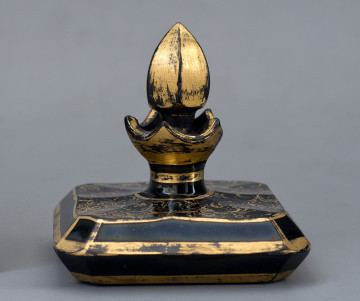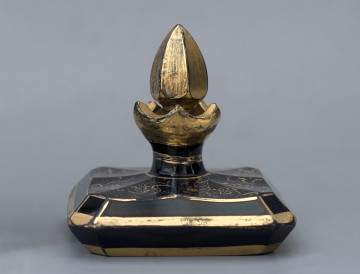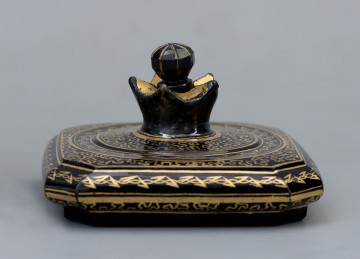
Vial with a cap
Museum of King Jan III's Palace at Wilanów
Part of the collection: European enamelworks
An epergne with a white–red decoration is an attractive usable product adorned with red coral taken out of the depths of the Mediterranean Sea. It is one of the most distinctive objects made in Sicilian craft workshops. Trapani was an outstanding centre of this production in the western part of the island. Because of their value, properties attributed to coral and difficulties in its acquisition, jewellery products and vessels decorated with coral were luxurious items. The items preserved most often in collections were variously shaped epergnes, caskets, cutlery items, white weapon sheaths and cult performance items, such as stoups, reliquaries, chalices, small crucifixes, devotional shrines or small crosses. The most desirable type of coral was the intense deep red one, but corals in other tones and shades can be encountered, too. The valuable material was often set in gold or – in less luxurious versions – in gilded copper. The Wilanów epergne plate of gilded copper fixed on a stubby cylindrical foot, was encrusted with coral seeds arranged into a thick ornament. The red coral is supplemented with fragments of white enamel entwined into the decoration as rosette flakes and an openwork frame with flower pinnacles. Two circles of symmetrically spread white–red rosettes passing each other are arranged around the central ring on the mirror and collar of the plate. Unfortunately, the white flakes of enamel in some rosettes have not survived, weakening the general decorative effect. It is characteristic that, as in the case of the Wilanów epergne, objects made in the 16th and 17th century included corals arranged under the outer metal openwork plate, in which appropriately shaped holes were cut precisely. The organic structure filling the openwork was pressed with the outer plate to prevent the movement or loss of coral. In the 18th century, corals were usually fastened with iron wires, which reduced the time of their setting. Their arrangement sometimes resembled a fragment of damask or velour textile with elevated parts of patterns. The bottom of the vessel was covered with a more modest, yet careful decoration with engraved styled vines. This visually attractive object was bought for the collection presumably by August Potocki and his wife Aleksandra during their journey to Italy. Therefore, it was shown to the Warsaw audience for the first time during An Exhibition of Antique and Art Objects in the palace of Count August Potocki and his wife at Krakowskie Przedmieście 32 (today the Museum of the University of Warsaw) in 1856. It is described in the catalogue of this exhibition under item 491. Interestingly, a similar vessel was added to the collection of the Czartoryski princes, which confirms the demand for such objects in collections gathered in the 18th and 19th century.
Joanna Paprocka-Gajek
Author / creator
Dimensions
entire object: height: 8,5 cm, width: 23,4 cm
Technique
enamel
Material
bronze,gold,coral
Owner
Museum of King Jan III's Palace at Wilanów
Identification number
Location / status

Museum of King Jan III's Palace at Wilanów

Museum of King Jan III's Palace at Wilanów

Museum of King Jan III's Palace at Wilanów
DISCOVER this TOPIC
Museum of King Jan III's Palace at Wilanów
DISCOVER this PATH
Educational path